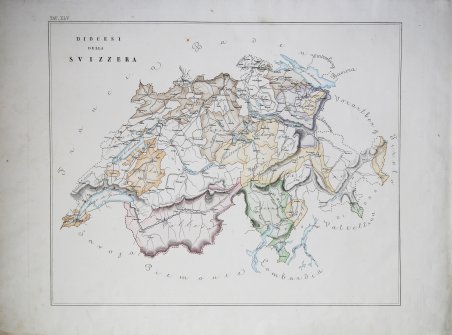Carta geografica raffigurante le legazioni ecclesiastiche della regione, tratta dall’Orbe Cattolico ' di Girolamo Petri. L'Orbe Cattolico ossia Atlante Geografico Storico Ecclesiastico ' fu pubblicato a Roma in 3 volumi nel 1858-1859. Le mappe di grande formato sono finemente incise e ben colorate. È senza dubbio una delle opere più finemente incise ed eleganti della metà del XIX secolo. Ogni mappa mostra le varie diocesi, ognuna delle quali è contraddistinta da colori vivaci che ne segnano la sede, e altre città importanti. Sebbene le caratteristiche geografiche siano chiaramente espresse, le mappe sono volutamente piuttosto scarne di dettagli, in modo da non sminuire visivamente il loro scopo, che è quello di mostrare le divisioni ecclesiastiche. Nel creare l'atlante, Petri ha sottolineato di aver attinto solo alle "fonti più attendibili", comprese le mappe degli archivi vaticani e delle diocesi d'oltremare L'atlante fu pubblicato in un numero molto limitato di esemplari ad uso esclusivo dei cardinali e degli amministratori di alto rango, il che ne spiega la grande rarità odierna. Girolamo Petri (1806 - 1871) fu una figura importante nell'amministrazione della Chiesa cattolica romana durante il regno di Pio IX. Nacque a Onano (Viterbo, Lazio), figlio di un funzionario vaticano che in seguito divenne governatore di Frascati. Il lavoro di Petri fu svolto in un periodo in cui la Chiesa era sotto assedio in Europa, ma, al contrario, aveva grandi ambizioni di espansione all'estero, in particolare in Asia e in Africa. La metà del XIX secolo fu un periodo di grandi cambiamenti a Roma. L'atlante faceva senza dubbio parte degli ultimi sforzi del Vaticano per comprendere e controllare la sua vasta influenza in tutto il mondo, resuscitando il concetto popolare di province ecclesiastiche diffuso nelle opere di Nicolas Sanson e altri cartografi del XVII secolo. La Calcografia Nazionale (Istituto per la Grafica) conserva ancora 135 rami di questo rarissimo atlante. Incisione in rame, coloritura coeva, in ottimo stato di conservazione. Bibliografia Walter Goffart, ' Historical Atlases: The First Three Hundred Years, 1570-1870 ' (Chicago, 2003), p. 427-8; J.A.B. Jongeneel, ' Philosophy, Science, and Theology of Mission in the 19th and 20th Centuries: A Missiological Encyclopedia ' (1995), p. 264. A very rare map showing the dioceses of Catholic organization, taken from ' L'Orbe Cattolico ' by Girolamo Petri. L’Orbe Cattolico ossia Atlante Geografico Storico Ecclesiastico’ ' was published in Rome in 3 volumes in 1858-1859. ' The large-format maps are finely engraved and beautifully colored. The atlas is a testament to the artistry of the engravers and the relative indifference of the publisher to the commercial success of the work. It is without question one of the most finely engraved and elegant works of the mid-19th Century. Each map shows the various dioceses, which are each distinguished by their own bright colors, marking their seats, as well as other major towns. While key geographical features are expressed throughout, the maps are otherwise intentionally rather sparing of detail, so as not to visually detract from their purpose, which is the show the ecclesiastical divisions. In creating the atlas, Petri noted that he drew only upon the “most trusted sources”, including maps from the Vatican archives and overseas dioceses. The atlas was by far and away the finest ecclesiastical atlas created during the 19th Century, featuring exceptionally beautiful examples of thematic cartography. The uncommonly beautiful atlas was published in only a very small number of examples for the exclusive use of Cardinals and high-ranking administrators, accounting for the great rarity today. Petri who was commissioned by Pope Pius XI thus created during a time when the Church was under siege within Europe, but, conversely, while it had major ambitions for expansion overseas, particularly in Asia and Africa. The mid-19th Century was a period of dramatic change in Rome. The atlas was no doubt part of the Vatican's last-ditch efforts to understand and control its vast influence around the world, resurrecting the popular concept of ecclesiastical provinces popularized in works by Nicholas Sanson and others during the 17th Century. The Calcografia Nazionale still preserves 135 copperplates of this extremely rare atlas. Bibliografia Walter Goffart, ' Historical Atlases: The First Three Hundred Years, 1570-1870 ' (Chicago, 2003), p. 427-8; J.A.B. Jongeneel, ' Philosophy, Science, and Theology of Mission in the 19th and 20th Centuries: A Missiological Encyclopedia ' (1995), p. 264. Cfr.


Find out how to use
Find out how to use

